- Details
Just returned from a Norwegian Holiday:
15 days of food on our backs on a selfsupporting 15-day-hike in the mountains.
Below our greeting-card as sent to friends; home-made from own pictures:
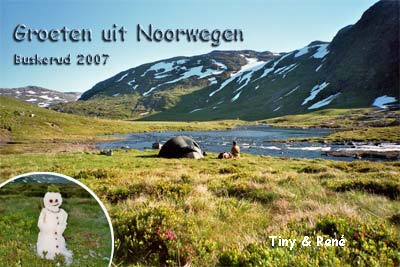
We also learned something: This year I had to leave my car at our starting point in the middle of nowhere in the mountains. As there was nobody nearby to inform about our plans, unfortunately someone started to worry. After 2 weeks he or she informed the police, who started a telephone-search in Holland. Even Hans Heupink got involved (see his weblog)
Direct motive was obviously the fact some tourists had accidents or died in the mountains this year, causing the Norwegians to be alert. Something to be praised of course.
How I can prevent this to happen during next year, shall be a point of study: whom in this empty country could I inform about our plans?
But I concluded that it is certainly advisable, as with seakayaking, to leave a "float-plan" somewhere. Not that I am afraid, looking at the fact we could look after ourselves during the last 15 years without car (thus nobody knowing about us), but for occasions like happened this year and to prevent unnecessary activities.
- Details
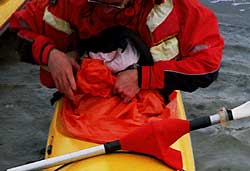 Once it has happened to me, a few years ago: just driven 200 km's for a day-paddle with Willem Molengraaff, when I discovered the sprayskirt was missing. As it was in the middle of the winter, paddling without it was no option. Drive back home is an option; although not a very pleasant one.
Once it has happened to me, a few years ago: just driven 200 km's for a day-paddle with Willem Molengraaff, when I discovered the sprayskirt was missing. As it was in the middle of the winter, paddling without it was no option. Drive back home is an option; although not a very pleasant one.
But first Willem and I tried to find a temporary solution.
As we were quite happy with the result, a "sprayskirt" which functioned the whole day just like a normal one, we are happy to share the idea with you.
Just in case you ever...........!
- Details
Independence Day in the USA is clearly a day on which quite a lot of people spend there time on the water.
Unfortunately this results in accidents sometimes. Having learned from the past the US Coastguard anticipates on this by publishing the following press release:
Date: July 2, 2007
Fourth of July Boating and Paddling Safety
BOSTON - The Fourth of July holiday is not only the busiest boating period of the year, but it also holds the distinction of being the deadliest, both nationwide and in the Notheast.
- Details
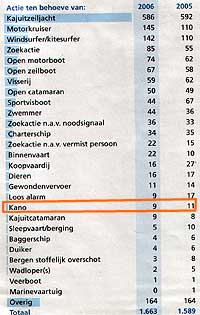
Last week I recieved the annual report of the KNRM (The Dutch rescue organisation)
They report to have carried out 1663 rescue operations during last year 2006.; from which in 9 occasions kayaks were involved.
Out of 1663 operations, meaning only 0.5%, you can´t call kayaking a risky sport. Looking at kitesurfing there is a significant difference as they claim 8.5% from the Dutch rescuers.
Looking for lessons I searched the KNRM-website [www.knrm.nl] for those 9 events. Unfortunately I only found 2 rescue reports about kayaks in 2006. May be it migth be concluded that the other 7 were only minor incidents.
- Details
Toggles; only a small part of seakayaks. Nevertheless, toggles can be handy or can have a safety-impact.
There are quite a lot of ways toggles are attached to seakayaks. Not all of them are sufficient to my opinion, but let's take a look at an anthology of toggles first:

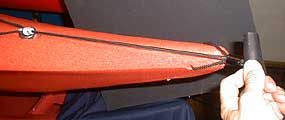

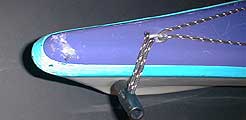
Next thing is to think about which functions a toggle can have:......................
- Details
As I had a rather nasty workingday last wednesday, I was looking for something to set my mind on other things. The idea was born to test the increase in speed when paddling my Lendal Kinetik Wing paddle if compared to a conventional paddle.
As you probably now from my website or weblog, I am working on a test with this paddle. Until now I only wrote a temporary testreport because I needed more time to get completely used to this paddle before I could judge all paddle techniques to do with the paddle. To give myself an extended testing period, and because my light weight paddle needs to be replaced, I bought myself such a paddle two years ago.
Normal paddling practise is quite good now since I, as well as all other muscles you need for this paddle, got used to this way of paddling. So, since a year or so I always paddle the wing.
Having concluded that this wing asks for a high concentration level to get the most speed from it, I had already for long an action-point: to investigate if you paddle really faster with this hybrid wing.
I call it a hybrid wing because it is kind of a mix between a conventional paddle and a competition wing. It has certainly not the grip a competition wing has.
The way to investigate the efficiency of the paddle long bothered my mind. The problem is of course there are influences as "getting tired", "wind", "waves" and many others.
Finally I decided to give it a try by taking 2 paddles with me and to change paddles in every comparable stretch of water, while measuring speed with a GPS.
So I did tonight.
Approach:
Paddles were:

Schlegel
weight: 1400g
lenght: 2,18m

Wing
weight: 900g
lenght: 2,21m
Circumstances: wind SW 4 - 6 Bft
- Details

Photo by Wieger
I just got the picture that Wieger made of me, paddling a Capella Rm, during some heavy rainfall a week ago while kayaking the voordelta.
We all enjoyed the sigth of the rain flattening the waves and creating a special perspective with the complete palet of grey colours.
- Details

Rapier 20
The reading of the testreport about the Rapier20 in the most recent issue of Seakayaker triggered me to think back to my discussion with Willem Molengraaff, a couple of months ago, as well to rolling sessions with all kind of different seakayaks in the years past by.
The trigger was the following text-passage about rolling the rapier:
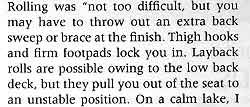
Following our discussion, We think of rolling a seakayak as an importanty issue because, when a kayak can be rolled easily, this adds to the safety by a bigger chance of succes under difficult circumstances.
Difficult to understand is: "WHY is a long, slim kayak like the rapier not easy to roll?"
- Details
In one of our outdoorshops I stumbled a few weeks ago over a leaflet mentioning the "Uribag".
What´s a Uribag?? Well this is a device, in the form of a latex bag, with which you can urinate under circumstances where is less privacy. Such a bag exists in a male- and a female-version:
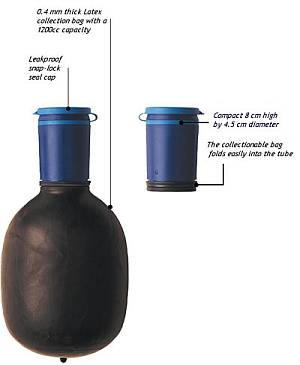

The moment I saw the leaflet, I instantly thought about the practical use for seakayaking. Honestly I can not see practical use for using the bag in a train or during backpacking or whatever sport. But in a seakayak this could be handy, supposing you have a wetsuite or drysuit with a release-zipper at the right place.
As the leaflet did not mention much information, nor an website-address, I did some searching with google.
And yes, they have a website!
The URL is: www.uribag.com
I am very curious if one of you, readers, heard before of the Uribag. And even more if anyone already tried it in the seakayak.
You are welcome to give your comments.
- Details
This was a wonderfull day.
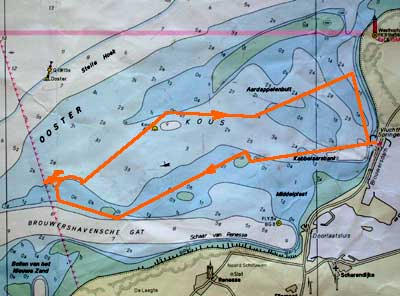
Because: I had not been in this area for a long time; the weather was interesting and challenging; the sea was very varied; there was a playspot with breaking waves AND my companions were happy with this tour.
The plan for today was to paddle in the Voordelta, departing from Springersdiep.
The windforecast was perfect with 3-4 Bft SW.
The difficult thing however was what to think off the occasional chance for "rain & thunder". The whole week already this was mentioned in the daily forecasts in the area, resulting only in rain without the thunder.
We discussed this with the coastguard and they said to contact us in case they noticed thunderactivity on the radar.
